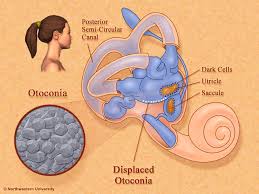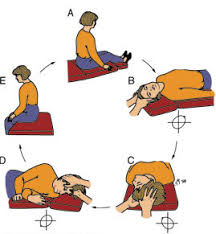

Benign paroxysmal positional vertigo (BPPV) is one of the most common causes of vertigo — the sudden sensation that you're spinning or that your head is spinning inside.
Benign paroxysmal positional vertigo is characterized by brief episodes of mild to intense dizziness. Symptoms of benign paroxysmal positional vertigo are triggered by specific changes in the position of your head, such as tipping your head up or down, and by lying down, turning over or sitting up in bed. You may also feel out of balance when standing or walking.
Although benign paroxysmal positional vertigo can be a bothersome problem, it's rarely serious except when it increases the chance of falls. You can receive effective treatment for benign paroxysmal positional vertigo during a doctor's office visit.
Symptoms
- Dizziness
- A sense that you or your surroundings are spinning or moving (vertigo)
- Lightheadedness
- Unsteadiness
- A loss of balance
- Blurred vision associated with the sensation of vertigo
- Nausea
- Vomiting
The signs and symptoms of BPPV can come and go, with symptoms commonly lasting less than one minute. Episodes of benign paroxysmal positional vertigo and other forms of vertigo can disappear for some time and then recur.
Activities that bring about the signs and symptoms of BPPV can vary from person to person, but are almost always brought on by a change in the position of your head. Abnormal rhythmic eye movements (nystagmus) usually accompany the symptoms of benign paroxysmal positional vertigo. Although rare, it's possible to have BPPV in both ears (bilateral BPPV).
When to see a doctor
Generally, see your doctor if you experience any unexplained dizziness or vertigo that recurs periodically for more than one week. Although it's uncommon for dizziness to signal a serious illness, see your doctor immediately if you experience dizziness or vertigo along with any of the following:
- A new, different or severe headache
- A fever of 101 F (38 C) or higher
- Double vision or loss of vision
- Hearing loss
- Trouble speaking
- Leg or arm weakness
- Loss of consciousness
- Falling or difficulty walking
- Numbness or tingling
- Chest pain, or rapid or slow heart rate
The signs and symptoms listed above may signal a more serious problem, such as stroke or a cardiac condition.
Causes
About half the time, doctors can't find a specific cause for BPPV.
When a cause can be determined, BPPV is often associated with a minor to severe blow to your head. Less common causes of BPPV include disorders that damage your inner ear or, rarely, damage that occurs during ear surgery or during prolonged positioning on your back.
The ear's role
Inside your ear is a tiny organ called the vestibular labyrinth. It includes three loop-shaped structures (semicircular canals) that contain fluid and fine, hair-like sensors that monitor the rotation of your head. Other structures (otolith organs) in your ear monitor movements of your head — up and down, right and left, back and forth — and your head's position related to gravity. These otolith organs — the utricle and saccule — contain crystals that make you sensitive to movement and gravity.
For a variety of reasons, these crystals can become dislodged. When they become dislodged, they can move into one of the semicircular canals — especially while you're lying down. This causes the semicircular canal to become sensitive to head position changes it would normally not respond to. As a result, you feel dizzy.
Risk factors
Benign paroxysmal positional vertigo occurs most often in people age 60 and older but can occur at any age. Aside from aging, there are no definite factors that may increase your risk of benign paroxysmal positional vertigo. However, a prior head injury or any other disorder of the balance organs of your ear may make you more susceptible to BPPV.
Complications
Although benign paroxysmal positional vertigo (BPPV) is uncomfortable, it rarely causes complications. In rare cases, if severe, persistent BPPV causes you to vomit frequently, you may be at risk of dehydration
Make an appointment with your doctor if you have symptoms that are common to BPPV. After an initial examination, your doctor may refer you to an ear, nose and throat (ENT) specialist or a doctor who specializes in the brain and nervous system (neurologist).
Here's some information to help you get ready for your appointment, and what to expect from your doctor.
What you can do
- Write down your symptoms, including when they started and how often they occur.
- Note any recent blows to your head, including even minor accidents or injuries.
- Make a list of your key medical information, including any other conditions for which you're being treated and the names of any medications, vitamins or supplements you're taking.
- Take a family member or friend along, if possible. Someone who accompanies you may remember something that you missed or forgot.
- Write down questions to ask your doctor. Creating your list of questions in advance can help you make the most of your time with your doctor.
Questions to ask the doctor at the initial appointment include:
- What are the possible causes of my symptoms or condition?
- What tests do you recommend?
- If these tests don't pinpoint the cause of my symptoms, what additional tests might I need?
- Do I need to follow any restrictions while we're seeking a diagnosis?
- Should I see a specialist?
Questions to ask if you are referred to a specialist include:
- What is my diagnosis?
- What treatments are most likely to help me feel better?
- How soon after beginning treatment should my symptoms start to improve?
- If the first treatment doesn't work, what will you recommend next?
- Am I a candidate for surgery? Why or why not?
- What self-care steps can help me manage this condition?
- Do I need to follow any activity restrictions? For how long?
- Am I at risk of this problem recurring?
- How often will you see me for follow-up visits?
- I have these other health conditions. How can I best manage them together?
- What handouts or websites do you recommend for learning more about BPPV?
If any additional questions occur to you during your medical appointments, don't hesitate to ask.
What to expect from your doctor
A doctor who sees you for symptoms common to BPPV may ask a number of questions, such as:
- What are your symptoms, and when did you first notice them?
- Do your symptoms come and go? How often?
- When symptoms occur, how long do they last?
- Is one or both of your ears affected?
- Does anything in particular seem to trigger your symptoms, such as certain types of movement or activity?
- Do your symptoms include vision problems?
- Do your symptoms include nausea or vomiting?
- Do your symptoms include headache?
- Have you lost any hearing?
- Have you had any weakness, numbness or tingling in your arms or your legs?
- Have you had any difficulty talking or walking?
- Have you had chest pain?
- Are you being treated for any other medical conditions?
- What medications are you currently taking, including over-the-counter and prescription drugs as well as vitamins and supplements?
Tests and diagnosis
Your doctor may do a series of tests to determine the cause of your dizziness. During a physical examination, your doctor will likely look for:
- Signs and symptoms of dizziness that are prompted by eye or head movements and then decrease in less than one minute
- Dizziness with specific eye movements that occur when you lie on your back with your head turned to one side and tipped slightly over the edge of the examination bed
- Involuntary movements of your eyes from side to side (nystagmus)
- Inability to control your eye movements
If the cause of your signs and symptoms is difficult to diagnose, your doctor may order additional testing, such as:
- Electronystagmography (ENG) or videonystagmography (VNG).The purpose of this test is to detect abnormal eye movement. ENG (which uses electrodes) or VNG (which uses small cameras) can help determine if dizziness is due to inner ear disease by measuring involuntary eye movements while your head is placed in different positions or your balance organs are stimulated with water or air. Other tests can assess your ability to maintain an upright position under easy and difficult conditions.
- Magnetic resonance imaging (MRI). This technique uses a magnetic field and radio waves to create cross-sectional images of your head and body. Your doctor can use these images to identify and diagnose a range of conditions. MRI may be performed to rule out acoustic neuroma — a noncancerous brain tumor of the nerve that carries sound and balance information from the inner ear to the brain — or other lesions that may be the cause of vertigo.
To help relieve benign paroxysmal positional vertigo (BPPV), your doctor, audiologist or physical therapist may treat you with a series of movements known as the canalith repositioning procedure.
Canalith repositioning
Performed in your doctor's office, the canalith repositioning procedure consists of several simple and slow maneuvers for positioning your head. The goal is to move particles from the fluid-filled semicircular canals of your inner ear into a tiny bag-like open area (vestibule) that houses one of the otolith organs (utricle) in your ear where these particles don't cause trouble and are more easily reabsorbed. Each position is held for about 30 seconds after any symptoms or abnormal eye movements stop. This procedure is usually effective after one or two treatments.
After the procedure, you must avoid lying flat or placing the treated ear below shoulder level for the rest of that day. For the first night following the procedure, you should elevate your head on a few pillows when you sleep. This allows time for the particles floating in your labyrinth to settle into your vestibule and be reabsorbed by the fluids in your inner ear.
On the morning after your in-office procedure, your restrictions will be lifted and you'll begin self-care as directed by your doctor. Your doctor likely will have taught you how to perform the canalith repositioning procedure on yourself so that you can do it at home before returning to the office for a recheck.
Surgical alternative
In rare situations in which the canalith repositioning procedure isn't effective, your doctor may recommend a surgical procedure in which a bone plug is used to block the portion of your inner ear that's causing dizziness. The plug prevents the semicircular canal in your ear from being able to respond to particle movements or head movements in general. This success rate for canal plugging surgery is greater than 90 percent.
home remedies
If you experience dizziness associated with benign paroxysmal positional vertigo (BPPV), consider these tips:
- Be aware of the possibility of losing your balance, which can lead to falling and serious injury.
- Sit down immediately when you feel dizzy.
- Use good lighting if you get up at night.
- Walk with a cane for stability, if you are at risk of a fall.
- Work closely with your doctor to manage your symptoms effectively.
BPPV may recur even after successful therapy. Fortunately, although there's no cure, the condition can be managed with physical therapy and home treatments.


